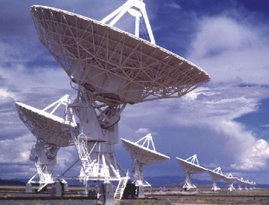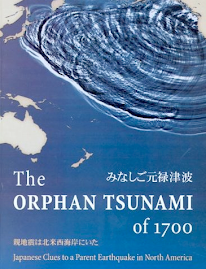
Monday, February 25, 2008
Life began... in ice?
This spectacular article the February 2008 Discover pulls all the pieces together, and after years of reading about all the bits and pieces, this smells right.
http://discovermagazine.com/2008/feb/did-life-evolve-in-ice
As I mentioned before, I think it is quite likely that we are not native to this planet. Life was probably seeded on Earth from Mars, or even from the ice moons of Jupiter or Saturn, because they were smaller and cooled more quickly than the Earth did. Asteroid and comet impacts then spewed huge amounts of material into space, and the archea cells were protected by the material and low temperatures in space. Life coming to Earth from another planet is called exogenesis.
As I mentioned before, I think it is also likely that we are not native to this star system. Life probably first arose on a planet billions of years ago in another star system, and material encasing archea cells was spewed throughout the entire galaxy long before the Earth formed. One or a few planets seeding the entirety of the galaxy is called panspermia.
So we can now sketch out the overall sequence.
After the Big Bang, the universe was mostly hydrogen and a little helium.
Stars formed and went supernova, producing the heavier elements. This process was repeated, and the amounts of heavier elements progressively increased.
Supernovas were more common toward the center of the galaxy, so there were more heavy elements toward the center of the galaxy.
On the other hand, if a supernova goes off nearby, it can easily sterilize the entire surface of a planet to a substantial depth, so being too near the center, while it would mean a lot of heavy elements would be present, would also mean that the surface would be sterilized fairly often. (However, now that we know how many archea live at great depths in the Earth, these sterilizations might actually present no problem at all.)
The Solar system is 4.5 billion years old, but we could easily imagine parts of the galaxy to have been rich in heavy elements 10 billion years ago.
So it is easy to imagine that on an ice planet in another star system 10 billion years ago, the processes described above in the Discover article took place, and the first archea cells formed and colonized the planet quickly.
Some cells were then blasted into space by impacts, encased in material that quickly cooled and protected the cells.
The materials spread across the galaxy relatively quickly, and some of it eventually landed on the ice moons of Jupiter and Saturn, and later, on a Mars covered by oceans, while the Earth was still molten.
The cells completely populated the moons and Mars.
Impacts on the ice moons and Mars ejected huge amounts of material into space, and some of it landed on Earth. If the Earth was still too hot, the cells would have died, but as soon as the Earth cooled so that there could be liquid water, the seeding would take place, and the cells then completely populated the Earth as it cooled.
So the processes described in the Discover article may actually have happened on another planet long before the Solar system formed. (And since our galaxy is made up of many smaller galaxies that have been incorporated into it, the origin of life may even have occurred in another galaxy.)
We may have good evidence for life on Mars in just a few months. In later missions, when samples are eventually returned from Mars and the DNA of the organisms is examined, if the DNA seems to be similar to that of the archea found on Earth, we could reasonably suppose that these cells had a common ancestor long before the Earth formed. That would be the greatest discovery of all time (so far) and would suggest that there are many planets in the galaxy with at least simple lifeforms... and that those lifeforms are all related... and that they are related to us.
We are on the verge of being able to detect Earthlike planets in other star systems.
Within the next few decades, we will have scanned a substantial part of the galaxy for other technical civilizations, so in our lifetimes, we will have either found another civilization, or we will begin to suspect that we are rare.
Here is part one of a program showing how life could be carried from planet to planet by impact debris.
http://discovermagazine.com/2008/feb/did-life-evolve-in-ice
As I mentioned before, I think it is quite likely that we are not native to this planet. Life was probably seeded on Earth from Mars, or even from the ice moons of Jupiter or Saturn, because they were smaller and cooled more quickly than the Earth did. Asteroid and comet impacts then spewed huge amounts of material into space, and the archea cells were protected by the material and low temperatures in space. Life coming to Earth from another planet is called exogenesis.
As I mentioned before, I think it is also likely that we are not native to this star system. Life probably first arose on a planet billions of years ago in another star system, and material encasing archea cells was spewed throughout the entire galaxy long before the Earth formed. One or a few planets seeding the entirety of the galaxy is called panspermia.
So we can now sketch out the overall sequence.
After the Big Bang, the universe was mostly hydrogen and a little helium.
Stars formed and went supernova, producing the heavier elements. This process was repeated, and the amounts of heavier elements progressively increased.
Supernovas were more common toward the center of the galaxy, so there were more heavy elements toward the center of the galaxy.
On the other hand, if a supernova goes off nearby, it can easily sterilize the entire surface of a planet to a substantial depth, so being too near the center, while it would mean a lot of heavy elements would be present, would also mean that the surface would be sterilized fairly often. (However, now that we know how many archea live at great depths in the Earth, these sterilizations might actually present no problem at all.)
The Solar system is 4.5 billion years old, but we could easily imagine parts of the galaxy to have been rich in heavy elements 10 billion years ago.
So it is easy to imagine that on an ice planet in another star system 10 billion years ago, the processes described above in the Discover article took place, and the first archea cells formed and colonized the planet quickly.
Some cells were then blasted into space by impacts, encased in material that quickly cooled and protected the cells.
The materials spread across the galaxy relatively quickly, and some of it eventually landed on the ice moons of Jupiter and Saturn, and later, on a Mars covered by oceans, while the Earth was still molten.
The cells completely populated the moons and Mars.
Impacts on the ice moons and Mars ejected huge amounts of material into space, and some of it landed on Earth. If the Earth was still too hot, the cells would have died, but as soon as the Earth cooled so that there could be liquid water, the seeding would take place, and the cells then completely populated the Earth as it cooled.
So the processes described in the Discover article may actually have happened on another planet long before the Solar system formed. (And since our galaxy is made up of many smaller galaxies that have been incorporated into it, the origin of life may even have occurred in another galaxy.)
We may have good evidence for life on Mars in just a few months. In later missions, when samples are eventually returned from Mars and the DNA of the organisms is examined, if the DNA seems to be similar to that of the archea found on Earth, we could reasonably suppose that these cells had a common ancestor long before the Earth formed. That would be the greatest discovery of all time (so far) and would suggest that there are many planets in the galaxy with at least simple lifeforms... and that those lifeforms are all related... and that they are related to us.
We are on the verge of being able to detect Earthlike planets in other star systems.
Within the next few decades, we will have scanned a substantial part of the galaxy for other technical civilizations, so in our lifetimes, we will have either found another civilization, or we will begin to suspect that we are rare.
Here is part one of a program showing how life could be carried from planet to planet by impact debris.
Subscribe to:
Post Comments (Atom)

No comments:
Post a Comment